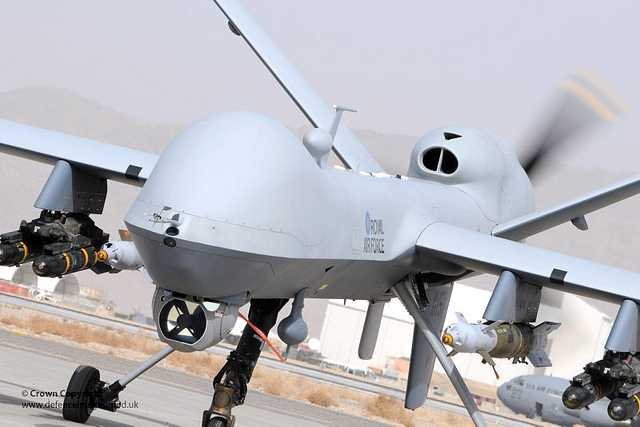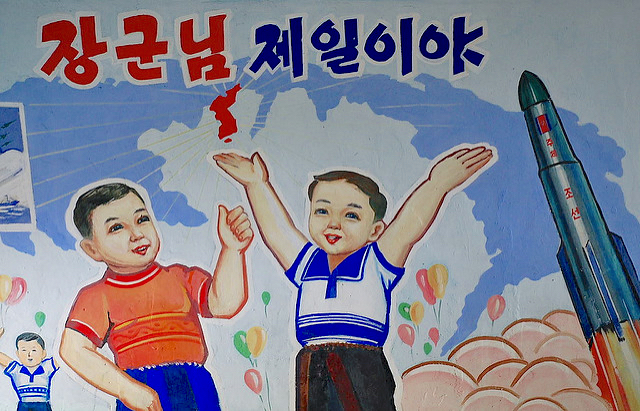The drone war, as it has been fought to this point, has featured an effective interweaving of military and ideological considerations. Grégoire Chamayou’s A Theory of the Drone represents the most comprehensive attempt to untangle the most politically complex aspects of drone use, and to explore its and psychological implications.
The drone is the weapon par excellence of the American imperium. It is the perfect expression of the asymmetric sovereignty that characterizes the international order of the 21st century, a condition in which states with the necessary technology can reconfigure the polities of those lower down the food chain by remote control. There is an extent to which this has been the case since the beginning of the era of colonialism, but technology has now made this process practically frictionless, if not exactly seamless.
The drone is the last word in low intensity warfare, a tactical and strategic tool that allows the United States (but soon others as well) to extend the range of its power without the need to draw back flag-draped caskets in return. And, if among the consequence of its employment is the elision of the distinction between soldier and civilian, and the telescoping of warfare into all conceivable futures, that seems (at least to the policymakers and their political enablers) like a relatively small price to pay.
Drones fulfill a certain kind of military logic, one which is particularly appealing to the United States in the era of war against polycephalus international terrorism. This is the sort of thing that has become indispensable for American power since the days of Vietnam. Prior to that, the United States tended to favor simple economic domination, resorting to the direct application (as opposed to via proxies) of massive physical force only in exceptional cases.
U.S. incursions in the Philippines, Nicaragua, the Dominican Republic, and Mexico (to take only some of the most prominent examples) as well as the genocide of the native peoples of North America, were brutal in the extreme. But particularly after U.S. territories in North America were fully subdued, domination by corporate interests, enforced by a cadre of local front men, was preferred to the formation of settler societies beyond the boundaries of the metropole on the European model.

The decades after World War II saw the United States dragged in to the morass of decolonization, as the exigencies of the nascent Cold War compelled successive administrations to try to channel the transition to self-rule away from the influence of the Eastern Bloc. The first and most spectacular of the incursions was in Indochina, where the U.S. allowed itself to be made the military guarantor first of French interests then, after Dien Bien Phu, and those of the non-Communist West more generally.
The costs were startling. A minimum of 50,000 dead U.S. troops, and more than 300,000 wounded, as well as a significant rupturing of the domestic social and political fabric of the United States. The matter of the million or more Vietnamese who lost their lives in the conflict was, of course, not for serious consideration among the U.S. policy elite. They were, and remain, expendable, just like the Iraqis that followed them in the 1990s and early 00s.
Vietnam was a learning experience for the United States, one that wrought profound changes on American society. Pace the claims of some on the right that the paucity of Communist takeovers post-1972 meant that Vietnam constituted a win, the conflict highlighted the limits of U.S. military power, particularly in terms of its capacity to deal technologically with counterinsurgency. In the course of its Arclight and Rolling Thunder operations, the United States dropped more ordinance on Vietnam than it had on Europe during the Second World War.
Yet these programs spectacularly failed to stem the flow of men and materiel to the Communist forces infiltrating the Republic of Vietnam. The combination of large numbers of American fatalities and failed military and political program has colored American strategic thinking ever since.
The early stages of the U.S.-led wars in Iraq and Afghanistan seemed to have wrought a change. The “Shock and Awe” bombardment preceding the U.S. invasion of Iraq, and the dramatic successes of the ground campaign that followed it, convinced many that the direct application of “smart” ordinance and boots on the ground could be an effective combination for the extension of U.S. political power around the globe.
But the insurgencies that followed, and the spreading of al-Qaeda as a polycephalous organization into semi-sovereign entities, such as Yemen, the tribal areas of Pakistan, and now the ISIS-ruled parts of Syria and Iraq, served once again to highlight the limitations of direct, massive military action. For these wars, fought in the shadows against an opponent that was difficult, often well-nigh impossible to distinguish from surrounding civilians, the Predator drone became an indispensable tool.

Chamayou’s book takes a long, hard look at this blurring of the distinction between civilian and combatant. The employment of drones has resulted in a simultaneous massive expansion and extreme contraction of the modern battlespace: extending its spaciality far beyond the boundaries of the sovereign states that were immediate parties to the conflict, while at the same time shrinking it to the dimensions of the rooms occupied by those determined to be militants, or sometimes to the very extent of the body itself.
The drone, so its defenders would have it, is a morally superior weapon in the sense that it limits collateral damage. With the capacity for individual surveillance and targeting, there is no longer the need for the piles of smoking corpses of Dresden, Hamburg, and Tokyo, to say nothing of the mushroom clouds above Hiroshima and Nagasaki. Chamayou argues that this misconstrues the proper point of comparison.
The drone is not meant to be a replacement for the B-52, but rather for the individual soldier and his weapon, putting his own life at risk in the face of his opponent. The drone allows for extensive surveillance and thus, so its defenders assert, the precise ascertainment of who is a “militant” and who is not through the use of ostensibly objective network and contact analyses.
But the effective abandonment of the pursuit of human intel, and the practical difficulties associated with retrospectively determining who exactly was killed in “bandit country” mean that these justifications become circular. Those killed are designated in the media as “militants,” but this designation has a much to do with the circumstances surrounding their demise as of any qualitative understanding of their situation preceding it.
One the more alarming aspect of Chamayou’s book is what we learn about the drone operators themselves. From time to time, one finds (seemingly obligatory) stories in the media about the potential emotional damage, sometimes rising to the level of PTSD, caused by watching shadowy figures for days on end before blowing them (and anyone who happens to stray within 15 meters of their location) to smithereens. Yet, as Chamayou notes, the psychological consequences of these experience are not really comparable to those suffered by soldiers who actually face the prospect of death or dismemberment.
The really notable thing about the human consequences of drone warfare (at least in terms of the operators) is not that it’s disturbing to them, but rather that is isn’t. Drone operators complain about the long hours, the boredom, and not getting the shifts that they want. With a small number of exceptions, the fact that their work results in the shattered bodies of complete strangers (to say nothing of their children and other family members) is not in itself a source of particular stress.
What we have instead are various attempts by those in military administration to create combat decorations for drone operators by twisting language in order to make the functional equivalent of a session of Eve Online comparable to the experience of combat infantry.
But it is the all-encompassing nature of drone warfare that is where the true threat lies. The capacity of drones to be infiltrated into spaces irrespective of questions of sovereignty effectively means that the entire world has been merged into the battlespace. Moreover, the employment of impersonal, and impersonally determined, death from above has the effect of generating more of the sort of thing that it is meant to prevent.
Every person, whether innocent or not, lives in a web of associations whose members are likely to desire some type of payback (and to take actions to obtain it) from those who acted as judge, jury, and executioner in a process with no right of appeal. A recent study by the human rights organization Reprieve found that U.S. attempts to kill 47 men with drone strikes in Yemen and Pakistan resulted in more than 1,100 “collateral” deaths.
It is a particular failing of the American imagination that the likelihood of this fact to trigger a perfectly natural impulse toward vengeance (and the taking of violent action toward that end) is hardly ever recognized. The use of drones has the potential to become, and is in fact becoming, imbricated in a self-reinforcing cycle of violence, in which each iteration leaves in its way the seeds of the next one.
Viewed in a certain light, the U.S. commitment to the drone war looks like a scene from the last period of the Roman Empire. In place of the barbarian tribes employed as proxies to guard the Roman frontiers, we have battalions of uncouth and (if the excrescences of Gamer Gate are anything to go by) uncivilized gamers being paid to take up the cudgels for a citadel culture that will always want to hold them at arm’s length.
Gone will be the days of the jet-powered knights errant, to be replaced by nameless, caffeine-swilling, carbon blobs inhabiting air-conditioned steel shipping containers. The preference of the Obama Administration for this mode of approach has generated a slew of tiresome nicknames (Obummer, Obomber, etc.) from disappointed progressives who inexplicably thought that his regime would somehow be less explosively aggressive than its potential Republican counterpart.
But the fact of the matter is that the genie is out of the drone storage unit, and that any conceivable administration, irrespective of party, will employ this tool simply because it allows them to avoid the frictional disincentive to policy deriving from the deaths of people about whom Americans actually care.
Yet our current situation is one of imbalance, both between our own technological capacities and those of our opponents, but also with the rival industrialized states of the world. The United States currently holds the E-ticket that is technological superiority in drone technology. But this should not be confused with a permanent situation.
There is no reason why future generations of Americans should not live their lives over the background music of the drone buzz, or with the knowledge of the possibility, perhaps the likelihood, that they were under surveillance by someone even more malevolent than their own government.
Photographs courtesy of the UK Ministry of Defence, U.S. Navy, and





